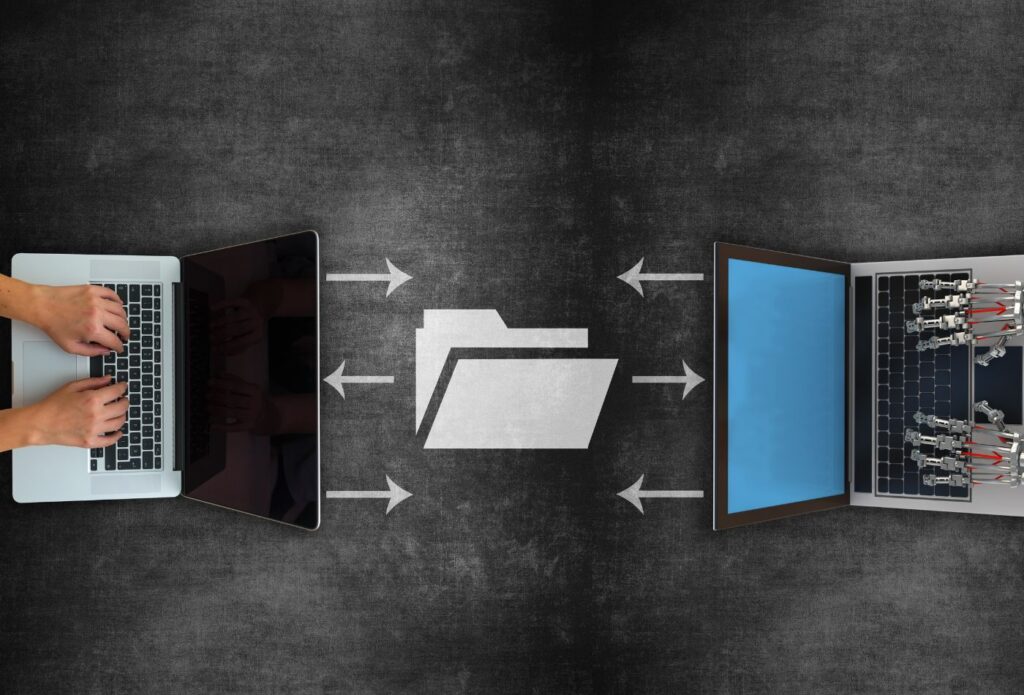In today’s fast-paced and digitally connected world, businesses of all sizes need to be more agile, organized, and collaborative than ever before. Whether you’re a small startup or a large corporation, the way you manage and share files can significantly impact your productivity, efficiency, and overall success. An efficient file-sharing system has become a must-have tool for businesses looking to streamline their operations and enhance collaboration.
In this post, we’ll explore why every business needs an efficient file-sharing system and how such a system can drive business success. We’ll delve into the benefits, challenges, and practical ways businesses can adopt and implement a secure, streamlined file-sharing solution.
1. The Growing Importance of File Sharing in Modern Business
Before diving into the specific benefits of an efficient file-sharing system, it’s important to understand why file sharing has become so crucial in today’s business world. With the rise of remote work, digital transformation, and the increasing reliance on cloud-based tools, businesses are facing new challenges in managing and sharing information.
Historically, businesses stored files on physical servers or shared them via email attachments. However, this traditional approach is no longer sufficient. As companies grow and operate in a more collaborative and distributed environment, file-sharing needs evolve.
An efficient file-sharing system helps businesses organize, store, access, and share files seamlessly across teams and departments. It allows businesses to centralize data, ensuring that employees can access the latest files at any time, from any location.
Key trends driving the need for efficient file sharing:
- Remote and Hybrid Work: The pandemic accelerated the shift to remote and hybrid work. Employees are no longer confined to a single office space, and the need for remote collaboration and access to files from anywhere has become a necessity.
- Increased Collaboration: The demand for teamwork and collaboration across departments, locations, and time zones is higher than ever. File sharing helps teams collaborate more effectively and stay aligned on projects.
- Data-Driven Decisions: Businesses today rely heavily on data. Sharing and accessing data efficiently allows companies to make informed decisions faster.
- Cloud Migration: More businesses are moving their operations to the cloud, creating a need for efficient, cloud-based file-sharing systems to support remote access and data security.
2. Key Benefits of an Efficient File Sharing System
Now that we’ve set the stage for why file sharing is important, let’s explore the specific benefits that an efficient file-sharing system brings to businesses.
1. Enhanced Collaboration
Collaboration is at the heart of any successful business. When employees, departments, or even external stakeholders need to collaborate on a project, the ability to share and edit files in real-time can make or break the success of that project.
An efficient file-sharing system enables seamless collaboration. Whether it’s co-editing a document, reviewing a presentation, or sharing a project update, file-sharing systems allow everyone involved to work together without the hassle of version control issues or waiting for email attachments to load.
Some of the collaboration benefits include:
- Real-Time Collaboration: Cloud-based file-sharing solutions allow multiple people to work on the same document at once, improving efficiency and reducing bottlenecks.
- Version Control: Keeping track of different versions of documents can be challenging, but file-sharing systems often provide automatic versioning to ensure that everyone is working with the most up-to-date file.
- Access Anywhere, Anytime: Employees can access shared files from any device, whether they’re in the office, at home, or on the go, promoting flexibility and productivity.
2. Increased Efficiency and Productivity
Efficiency and productivity go hand-in-hand when it comes to file sharing. An organized and easily accessible file-sharing system reduces time spent searching for documents or waiting for files to be emailed. With cloud-based file sharing, documents are always available, making it easier for employees to get their work done faster.
Imagine a scenario where an employee is working on a proposal with a colleague from another department. Without a proper file-sharing system, they would have to email back and forth, dealing with multiple versions, attachments, and file sizes. This process can be time-consuming and error-prone. However, with a file-sharing system, both employees can access the document in real-time, collaborate, and make updates instantly.
3. Improved Data Security
Data security is a top priority for businesses, especially with increasing cybersecurity threats and data privacy regulations such as GDPR. A secure file-sharing system ensures that sensitive business data is stored and transmitted safely.
With traditional methods like emailing files or storing them on local servers, businesses run the risk of data breaches, unauthorized access, or accidental loss of important files. A modern file-sharing system provides:
- Encryption: Ensures that files are encrypted both in transit and at rest, preventing unauthorized access.
- Access Control: Administrators can set permissions and control who has access to specific files and folders, ensuring that only authorized personnel can view or edit sensitive data.
- Audit Trails: File-sharing systems often include logging features that track who accessed or edited a file and when, helping businesses monitor and control file access.
4. Cost Savings
Managing physical storage and old-fashioned file-sharing methods like faxing or mailing can be costly. An efficient file-sharing system can reduce these costs significantly by moving everything to the cloud. With a cloud-based solution, businesses eliminate the need for on-premises infrastructure and reduce overhead costs associated with managing servers and physical data storage.
Additionally, cloud storage is often scalable, meaning that businesses only pay for what they use. This pay-as-you-go model is much more cost-effective than maintaining and upgrading in-house infrastructure.
5. Better Version Control and Tracking
One of the major problems with traditional file-sharing methods is keeping track of versions. Without an organized system, employees can easily overwrite documents or work on outdated versions, leading to confusion and errors.
An efficient file-sharing system addresses this by automatically managing versions and making it easy to track changes. Most modern systems allow you to see version histories, compare versions, and even revert to previous versions if needed. This functionality is especially important for businesses working with collaborative documents or large teams.
6. Enhanced Customer Experience
File sharing isn’t just beneficial for internal operations—it can also enhance the experience for your customers. For instance, if your business provides services that require document sharing (like contracts, project proposals, or invoices), a streamlined and efficient file-sharing system can help deliver those documents faster and more securely.
Customers appreciate fast and secure delivery of files, and a well-implemented file-sharing system can improve customer satisfaction and trust. Moreover, you can provide customers with access to shared files through secure portals, offering transparency and improving communication.
3. Challenges of Inefficient File Sharing
While the benefits of an efficient file-sharing system are clear, it’s important to understand the challenges that businesses face when they don’t have such a system in place.
1. Poor Collaboration
Without a proper file-sharing system, employees may struggle to collaborate effectively. Multiple versions of a document, inconsistent naming conventions, and miscommunication can lead to confusion and delays.
2. Security Risks
Using outdated or insecure file-sharing methods (like email or unencrypted cloud drives) increases the risk of data breaches, leaks, and unauthorized access. Sensitive business information may be exposed to hackers or third parties.
3. Time Wasted Searching for Files
In an inefficient file-sharing system, employees can waste significant time searching for files, especially if documents are poorly organized or stored in multiple locations. This wasted time can affect overall productivity and cost the business money in the long run.
4. File Loss and Data Corruption
Without proper backup systems and file versioning, files can be lost or corrupted. This risk is especially prevalent in businesses that rely on manual processes for backing up files or who don’t have a disaster recovery plan in place.
4. How to Implement an Efficient File Sharing System
Now that we’ve covered the benefits and challenges, let’s look at how businesses can implement an efficient file-sharing system.
1. Choose the Right File-Sharing Platform
There are many file-sharing solutions available, ranging from cloud storage services like Google Drive, Dropbox, and Box to more enterprise-focused platforms like SharePoint and OneDrive. The key is to choose the platform that fits your business needs and budget.
When evaluating a file-sharing platform, consider:
- Storage Capacity: Does the platform offer enough storage for your business needs?
- Collaboration Features: Does the platform support real-time collaboration, versioning, and commenting?
- Security Features: What level of security does the platform offer (encryption, access controls, audit trails)?
- Integration with Other Tools: Does the platform integrate well with your other business tools, such as CRM, project management software, and communication apps?
2. Train Your Team
Once you’ve chosen the right system, it’s important to train your team on how to use it effectively. Provide training on how to upload, share, and access files, as well as how to set permissions and control access.
3. Establish File Management Policies
To ensure that your file-sharing system remains organized and efficient, create clear file management policies. These policies should include:
- Folder Structures: How files should be organized and named.
- Access Permissions: Who can access, edit, or delete specific files.
- Backup Procedures: How often files should be backed up and where backups should be stored.
4. Monitor and Update the System
As your business grows and your needs evolve, it’s important to periodically review and update your file-sharing system. Monitor usage, gather feedback from employees, and make necessary adjustments to keep the system efficient and secure.
Conclusion
In today’s fast-paced business environment, an efficient file-sharing system is no longer a luxury—it’s a necessity. From enhanced collaboration and productivity to improved security and cost savings, the benefits of a well-implemented file-sharing system are clear. By choosing the right platform, training your team, and establishing clear policies, businesses can ensure that their file-sharing processes are streamlined, secure, and effective, ultimately driving greater success and growth.









